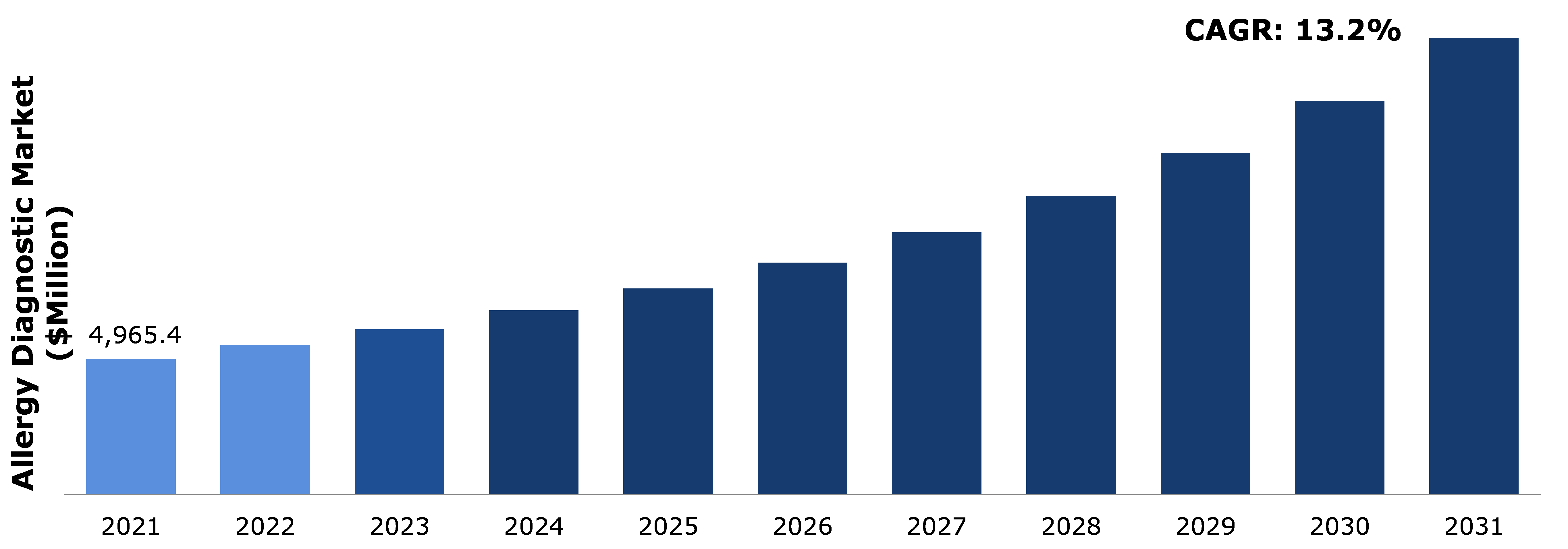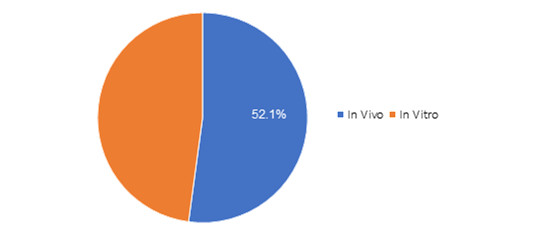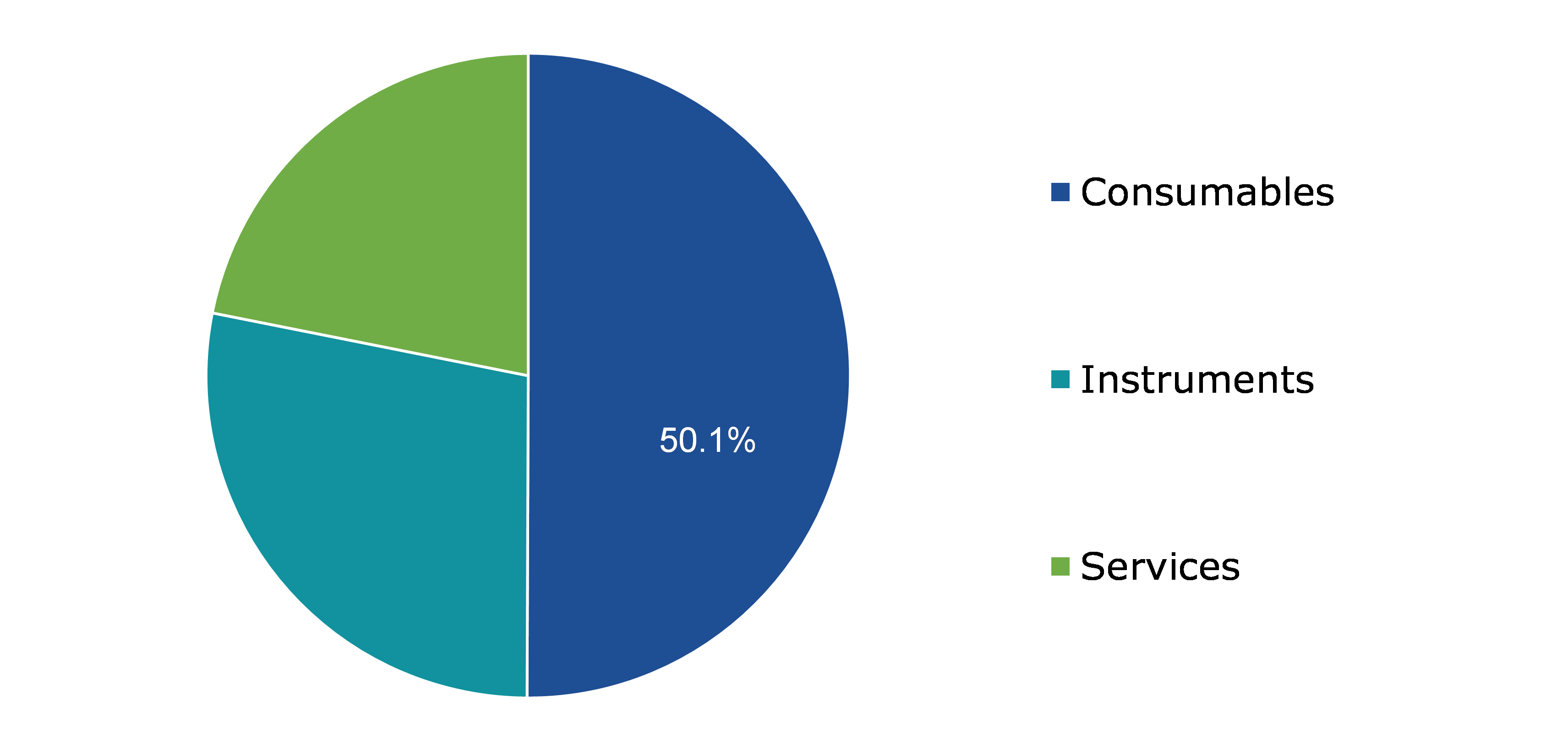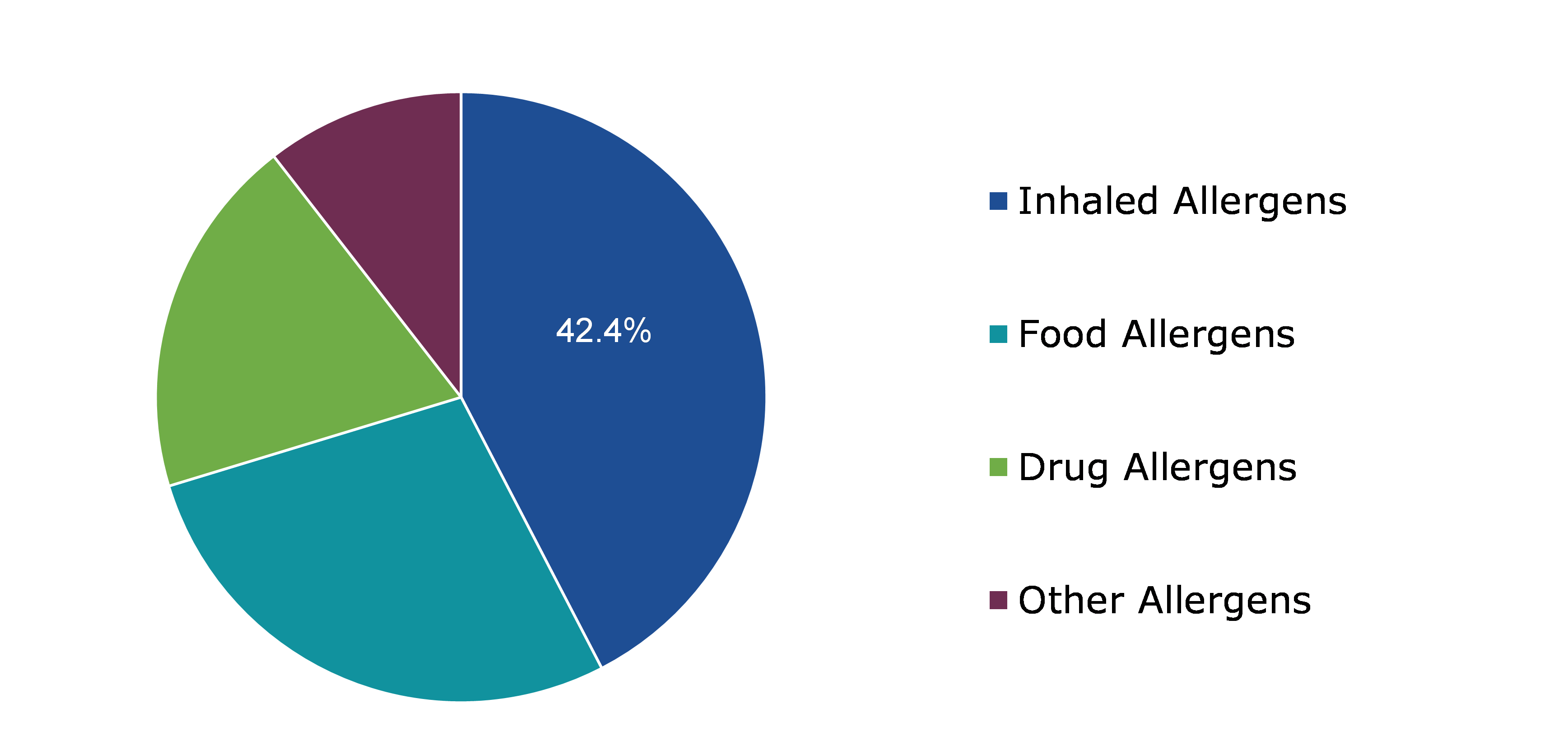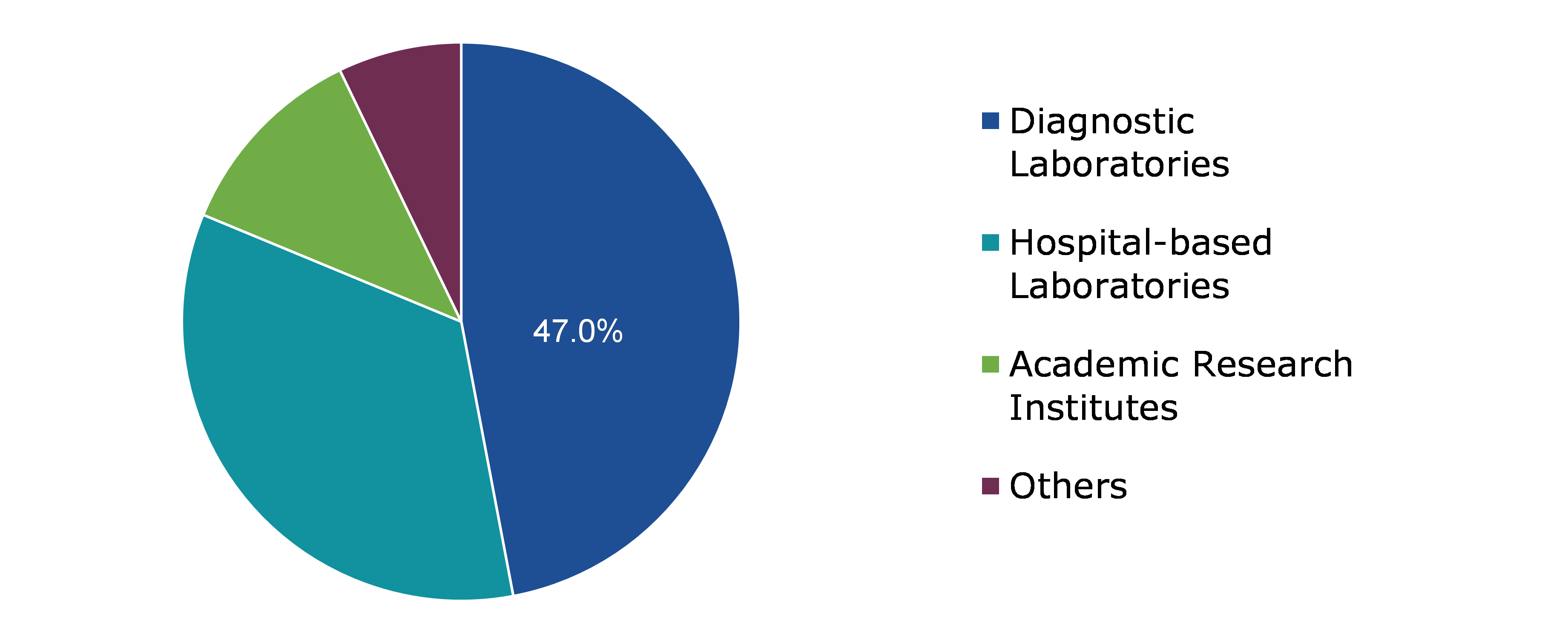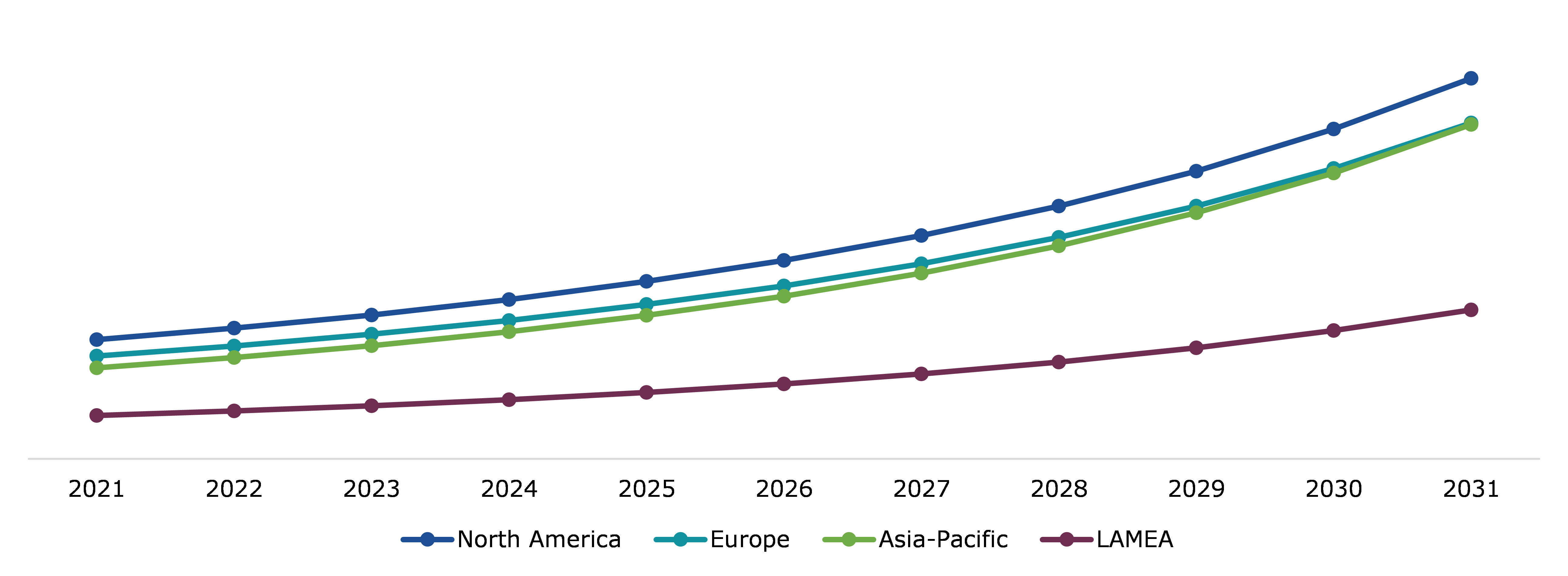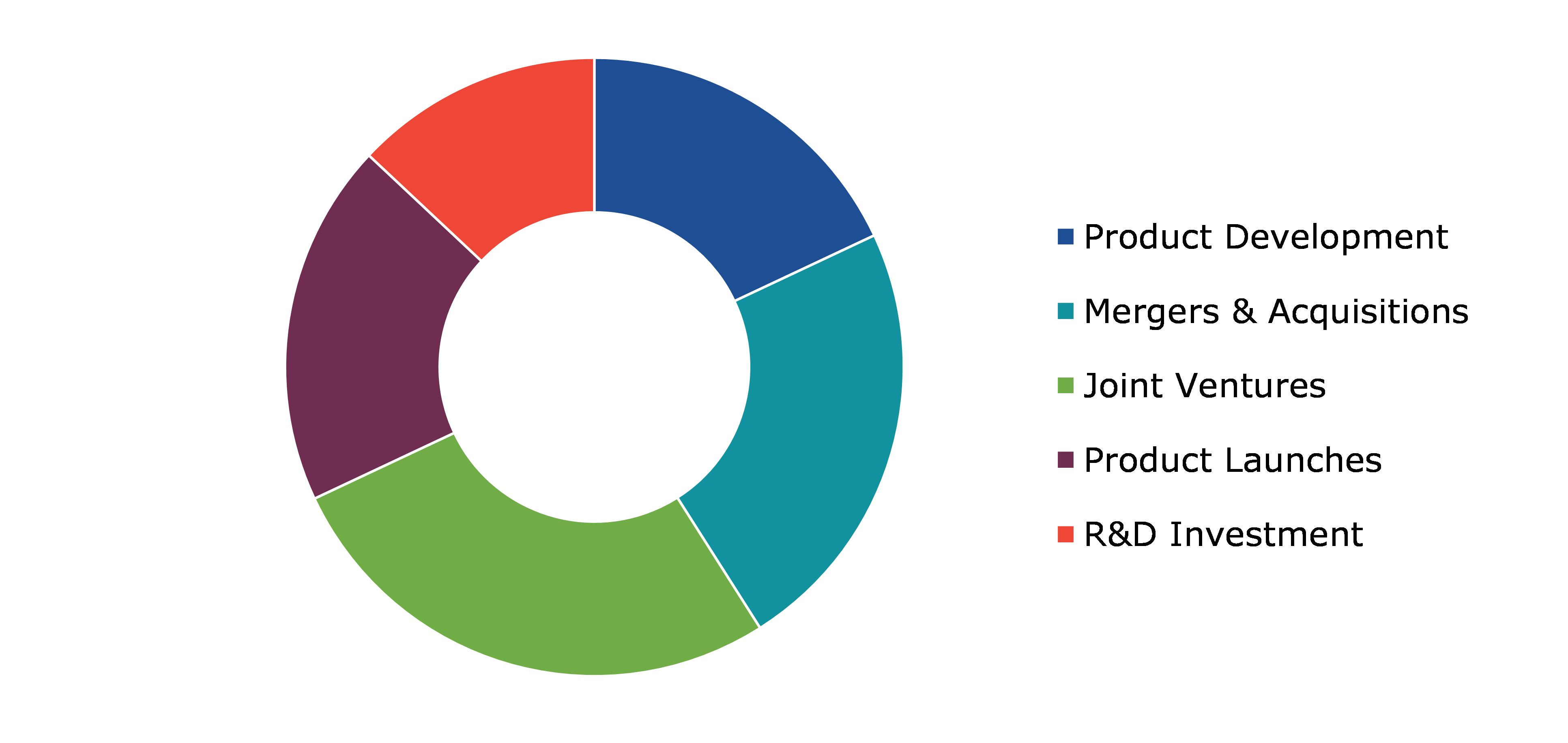Allergy Diagnostic Market Report
RA01184
Allergy Diagnostic Market by Test Type (In Vivo and In Vitro), Product/Service (Consumables, Instruments, and Services), Allergen (Inhaled Allergens, Food Allergens, Drug Allergens, and Other Allergens), End User (Diagnostic Laboratories, Hospital-based Laboratories, Academic Research Institutes, and Others), and Regional Analysis (North America, Europe, Asia-Pacific, and LAMEA): Global Opportunity Analysis and Industry Forecast, 2022–2031
Global Allergy Diagnostic Market Analysis
The Global Allergy Diagnostic Market Size was $4,965.4 million in 2021 and is predicted to grow with a CAGR of 13.2%, by generating revenue of $16,714.2 million by 2031.
Global Allergy Diagnostic Market Synopsis
Exposure to indoor and outdoor air pollution, allergens, and occupational exposure are the key risk factors underlying chronic respiratory illnesses. The prevalence of allergy disorders among the urban population is higher than those living in rural areas due to the higher exposure to environmental contaminants in cities (as a result of traffic pollution and industrial activity). Epidemiological and toxicological research demonstrates a causal association between air pollution and the increase in incidence of asthma, allergic rhinitis, and other allergic illnesses. Furthermore, studies have shown a significant rise in the incidence and deterioration of asthma in metropolitan areas with higher PM 2.5 (particulate matter of size 2.5 micrometers or less), nitrogen dioxide, and ozone concentrations.
Large hospitals and diagnostic laboratories have a larger share of this market as they have significant capital budgets to finance high-volume systems. However, most small laboratories, physicians’ clinics, and independent practitioners have budget limits, due to which they normally cannot afford large or extremely large medical equipment. Thus, high fixed-cost requirements are projected to hamper the growth of the allergy diagnostic market.
The use of mHealth for the diagnosis of rhinitis is currently limited, with only a small number of mHealth tools for allergic rhinitis (AR) diagnosis published in peer-reviewed journals. Recent breakthroughs in integrated biosensors, wireless connectivity, and power harvesting techniques generate a new breed of point-of-care devices. However, AR is a relatively prevalent condition. Any diagnostic equipment connected to a smartphone (e.g., peak nasal inspiratory flow meters or intranasal biosensors) would need to be inexpensive to be economical.
Allergy Diagnostic Overview
An allergy is a response or hypersensitivity that is induced by the immune system. The substance that causes allergic reactions is termed an allergen, for instance, pollen, dust mite secretion, and others. Medication allergy, fungal allergy, insect allergy, food allergy, and skin allergy are some of the more common allergies. Furthermore, allergy diagnostics is the process of determining the nature of an allergy and then treating it. Some of the common tests for diagnosis of allergies are intradermal, skin prick, patch, and blood testing.
COVID-19 Impact on Global Allergy Diagnostic Market
The COVID-19 pandemic has created multiple uncertainties, leading to huge economic losses as various companies across the world were shutdown. The coronavirus pandemic had a severe effect on various markets, including the allergy diagnostics market, which suffered reduced growth during this period. Due to complete lockdown and fear of spreading coronavirus, diagnostic tests were avoided in most of the allergic reactions. Moreover, allergists across the globe are choosing to use telemedicine for rhinitis and asthma during the COVID-19 pandemic. Therefore, such issues are projected to minimize global market growth.
Most of the allergies were treated through telemedicine or postponed. Furthermore, severe asthma patients cannot travel much due to restricted facilities for face-to-face visits under critical conditions. On the contrary, firms functioning in the allergy diagnostics industry are coming up with fresh techniques, amid COVID-19 impact on the allergy diagnostic market. For instance, in March 2021, FARE, the world's largest non-profit organization dedicated to food allergy awareness, announced the formal commencement of the multi-year competition, ‘FAITH Challenge’. It is a global research competition designed to produce a compassionate and safe diagnostic tool for people with food allergies. Such significant initiatives may contribute to the growth of the global allergy diagnostic market following the COVID-19 pandemic.
Increasing Environmental Pollution Level to Surge the Market Growth
The global allergy diagnostics business is witnessing a tremendous rise, mainly due to increasing air pollution that can cause chronic respiratory disorders, consequently driving the market growth. Morever, World Health Organization (WHO) indicated that around 80% of the people reside in metropolitan areas, so they are greatly affected by air quality, mainly in low-income nations. Furthermore, numerous research studies show a link between air pollution and allergic rhinitis, asthma, and other issues that are contributing to the overall increase in allergy diagnose. Companies that are emerging in the allergy diagnostics industry are already leading players in innovating strategies for clients. For example, on February 20, 2020, the UK’s National Measurement Laboratory (NML) launched the first-ever multi-allergen reference material kit featuring five common allergens. Some of the typical allergen kits include eggs, milk, walnut, hazelnut, and almond. These types of activities by market players are also projected to drive the allergy diagnostic market growth.
To know more about global allergy diagnostic market drivers, get in touch with our analysts here.
High Cost of Allergy Diagnostic to Restrain the Market Growth
The allergy diagnostics instruments are very pricey, hence, they are charging a high cost for service for allergy diagnostics tests. Some of the common diagnostic devices are ELISA analyzers, luminometers, immunoassay analyzers, blot analyzers, and scanners. Moreover, the cost of an immunoassay analyzer is $10,000, while the cost of fully automated analyzers is around $14,000. Furthermore, such devices require maintenance, laboratory supervision, operational costs, and others. All such elements are projected to hamper the market value of allergy diagnostics in the following few years.
Increase in Trends of mHealth in the Allergy Diagnostic to Create Massive Investment Opportunities
The global allergy diagnostic market trend is increasing at a very quick rate; hence, researchers and scientists have set up their R&D operations to produce the latest technological gadgets for better use of allergy diagnostics employing mobile phones. Moreover, using mHealth in allergy diagnostics can assist allergists to communicate with their patients with the help of motion sensors, messaging, cameras, and video calls. Therefore, allergy diagnostics through mobile health tools help doctors determine the level of allergy by documenting symptoms, thereby favorably affecting the market growth. Furthermore, the allergy diagnostics sector already has major market competitors creating tactics to gain clients. For example, Acar’Up Consumer Health, Belgian based healthcare company, launched ‘ExAller dust mite allergy self-test’. This test kit permits the patient to take a self-test at home in five minutes, by detecting specific antibodies in the blood that is created by the immune system in reaction to a dust mite. All the items that the company sells are clinically certified. All such characteristics may further contribute to profitable market prospects for important companies in the next few years.
To know more about global allergy diagnostic market opportunities, get in touch with our analysts here.
Global Allergy Diagnostic Market, by Test Type
Based on test type, the market has been divided into in vivo and in vitro sub-segments. Among these, the in vivo sub-segment accounted for the highest market share in 2021, whereas the in vitro sub-segment is estimated to show the fastest growth during the forecast period.
Global Allergy Diagnostic Market Trends, by Test Type, 2021
Source: Research Dive Analysis
The in vivo sub-segment is anticipated to have a dominant allergy diagnostic market share and generate revenue of $8,474.9 million by 2031, growing from $2,588.8 million in 2021. The two main types of in vivo allergy tests are organ challenge tests and skin tests. Both are intended to establish hypersensitivity and pinpoint the antigen that triggered the allergic response. The adoption of various in vivo tests, such as skin prick tests, is a major factor in this segment's growth. These tests are more reliable, secure, usable, and affordable than in vitro tests.
The in vitro sub-segment is anticipated to show the fastest growth and generate revenue of $8,239.3 million by 2031, increasing from $2,376.6 million in 2021. The vitro test is used to find the presence of allergen-specific immunoglobulin E (IgE). The radioallergosorbent test is an in-vitro approach for detecting allergen-specific antibodies of a novel immunoglobulin class, tentatively known as IgND. The benefits of in vitro testing include the absence of steroids or anti-histaminic effects, compatibility with any skin condition, and the absence of systemic reaction risk. For detecting aeroallergen (pollen and insect) sensitization, serum sIgE has a larger positive predictive value and superior specificity.
Global Allergy Diagnostic Market, by Product Service
Based on product/service, the market has been divided into consumables, instruments, and services sub-segments. Among these, the consumables sub-segment accounted for the highest revenue share in 2021.
Global Allergy Diagnostic Market Value, by Product Services, 2021
Source: Research Dive Analysis
The consumables sub-segment is anticipated to have a dominant allergy diagnostic market share and generate revenue of $8,658.1 million by 2031, growing from $2,485.6 million in 2021. Leading manufacturers operating in the market are employing strategic alliances to provide allergy diagnostics to customers. For instance, bioMérieux India Private Limited, one of the leading players in the industry, introduced the VIDAS Allergy Panel, the main purpose of which is to examine food and respiratory allergens. These variables and strategic collaborations by prominent organizations are predicted to boost the growth of the sub-segment during the projection period.
Global Allergy Diagnostic Market, by Allergen
On the basis of allergen, the market has been sub-segmented into inhaled allergens, food allergens, drug allergens, and other allergens. Among the mentioned sub-segments, the food allergens sub-segment is predicted to show the fastest growth.
Global Allergy Diagnostic Market Share, by Allergen, 2021
Source: Research Dive Analysis
The food allergens sub-segment of the global allergy diagnostic market demand is predicted to have the fastest growth. Moreover, itis anticipated to surpass $5,040.3 million by 2031, with an increase from $1,386.2 million in 2021. This increase in the market can be due to rise in food allergies among people in both developing and developed countries. Moreover, prominent market participants are adopting tactics to persist in a competitive environment. For instance, Romer Labs Division Holding GmbH, a global producer of diagnostic solutions, revealed in 2019 that they launched food allergen testing in APAC locations. All such elements may enhance the demand for sub-segment and hence spike the market growth.
Global Allergy Diagnostic Market, by End User
On the basis of end user, the market has been sub-segmented into diagnostic laboratories, hospital-based laboratories, academic research institutes, and others. Among the mentioned sub-segments, the diagnostic laboratories sub-segment is predicted to show the fastest growth as well as garner the dominant market share.
Global Allergy Diagnostic Market Size, by End-user, 2021
Source: Research Dive Analysis
The diagnostic laboratories sub-segment of the global allergy diagnostic market is predicted to have the fastest as well as dominant growth in the market. It is also anticipated to surpass $8,199.8 million by 2031, with an increase from $2,334.6 million in 2021. The rise of the sub-segment is mostly attributable to increase in trends of diagnostic laboratories owing to the desire for proper diagnosis among patients combined with increasing requirements for independent diagnostic laboratories. All such elements may raise the necessity for diagnostic laboratories and further spur the allergy diagnostic market share growth.
Global Allergy Diagnostic Market, Regional Insights
The allergy diagnostic market revenue was investigated across North America, Europe, Asia-Pacific, and LAMEA.
Global Allergy Diagnostic Market Size & Forecast, by Region, 2021-2031 (USD Million)
Source: Research Dive Analysis
The Market for Allergy Diagnostic in North America to be the Most Dominant
The North America allergy diagnostic market size was $1,661.4 million in 2021 and is projected to grow at a CAGR of 12.6%. The extensive growth of the North American allergy diagnostics market is mainly driven by improved medical insurance policies, number of people with allergies, good healthcare infrastructure, and advanced diagnostic technologies. Moreover, the strong presence of top allergy diagnostic providers and manufacturers that offer innovative allergy diagnostics tests is propelling the market expansion around the globe. These factors is anticipated to ultimately fuel the demand for the allergy diagnostic market analysis across the region.
Competitive Scenario in the Global Allergy Diagnostic Market
Product launches and mergers & acquisitions are common strategies followed by major market players. For instance, in 2018, Omega Diagnostics Group Plc and Immunodiagnostic Systems (IDS) entered into a supply agreement through which Immunodiagnostic Systems (IDS) is the official distributor of allergy tests offered by Omega Diagnostics Group Plc.
Source: Research Dive Analysis
Some of the leading allergy diagnostics market players are Thermo Fisher Scientific, PerkinElmer Inc., Danaher, Hitachi Chemicals, BIOMÉRIEUX, Omega Diagnostics Group PLC, Siemens, Eurofins Scientific, Stallergenes Greer, and Neogen Corporation.
| Aspect | Particulars |
| Historical Market Estimations | 2020 |
| Base Year for Market Estimation | 2021 |
| Forecast Timeline for Market Projection | 2022-2031 |
| Geographical Scope | North America, Europe, Asia-Pacific, and LAMEA |
| Segmentation by Test Type |
|
| Segmentation by Product/Service |
|
| Segmentation by Allergen |
|
| Segmentation by End User |
|
| Key Companies Profiled |
|
Q1. What is the size of the global allergy diagnostic market?
A. The size of the global allergy diagnostics market was over $4,965.4 million in 2021 and is projected to reach $16,714.2 million by 2031.
Q2. Which are the major companies in the allergy diagnostic market?
A. Thermo Fisher, Perkin Elmer, and Siemen are some of the key players in the global allergy diagnostics market.
Q3. Which region, among others, possesses greater investment opportunities in the near future?
A. The Asia-Pacific region possesses great investment opportunities for investors to witness the most promising growth in the future.
Q4. What will be the growth rate of the Asia-Pacific allergy diagnostic market?
A. Asia-Pacific allergy diagnostics market is anticipated to grow at 14.2% CAGR during the forecast period.
Q5. What are the strategies opted by the leading players in this market?
A. Technological development and strategic partnerships are the key strategies opted by the operating companies in this market.
Q6. Which companies are investing more on R&D practices?
A. Perkin Elmer and Siemen are increasing their R&D investments to develop new products and technologies.
1.Research Methodology
1.1.Desk Research
1.2.Real time insights and validation
1.3.Forecast model
1.4.Assumptions and forecast parameters
1.5.Market size estimation
1.5.1.Top-down approach
1.5.2.Bottom-up approach
2.Report Scope
2.1.Market definition
2.2.Key objectives of the study
2.3.Report overview
2.4.Market segmentation
2.5.Overview of the impact of COVID-19 on Global Allergy Diagnostic Market
3.Executive Summary
4.Market Overview
4.1.Introduction
4.2.Growth impact forces
4.2.1.Drivers
4.2.2.Restraints
4.2.3.Opportunities
4.3.Market value chain analysis
4.3.1.List of raw material suppliers
4.3.2.List of manufacturers
4.3.3.List of distributors
4.4.Innovation & sustainability matrices
4.4.1.Technology matrix
4.4.2.Regulatory matrix
4.5.Porter’s five forces analysis
4.5.1.Bargaining power of suppliers
4.5.2.Bargaining power of consumers
4.5.3.Threat of substitutes
4.5.4.Threat of new entrants
4.5.5.Competitive rivalry intensity
4.6.PESTLE analysis
4.6.1.Political
4.6.2.Economical
4.6.3.Social
4.6.4.Technological
4.6.5.LEGAL
4.6.6.Environmental
4.7.Impact of COVID-19 on Allergy Diagnostic Market
4.7.1.Pre-covid market scenario
4.7.2.Post-covid market scenario
5.Allergy Diagnostic Market Analysis, by Test Type
5.1.Overview
5.2.In Vivo
5.2.1.Definition, key trends, growth factors, and opportunities, 2021-2031
5.2.2.Market size analysis, by region, 2021-2031
5.2.3.Market share analysis, by country, 2021-2031
5.3. In Vitro
5.3.1.Definition, key trends, growth factors, and opportunities, 2021-2031
5.3.2.Market size analysis, by region, 2021-2031
5.3.3.Market share analysis, by country, 2021-2031
5.4.Research Dive Exclusive Insights
5.4.1.Market attractiveness, 2021-2031
5.4.2.Competition heatmap, 2021-2031
6.Allergy Diagnostic Market Analysis, by Product/Service
6.1.Overview
6.2.Consumables
6.2.1.Definition, key trends, growth factors, and opportunities, 2021-2031
6.2.2.Market size analysis, by region, 2021-2031
6.2.3.Market share analysis, by country, 2021-2031
6.3. Instruments
6.3.1.Definition, key trends, growth factors, and opportunities, 2021-2030
6.3.2.Market size analysis, by region, 2021-2031
6.3.3.Market share analysis, by country, 2021-2031
6.4.Services
6.4.1.Definition, key trends, growth factors, and opportunities, 2021-2030
6.4.2.Market size analysis, by region, 2021-2031
6.4.3.Market share analysis, by country, 2021-2031
6.5.Research Dive Exclusive Insights
6.5.1.Market attractiveness, 2021-2031
6.5.2.Competition heatmap, 2021-2031
7.Allergy Diagnostic Market Analysis, by Allergen
7.1.Inhaled Allergens
7.1.1.Definition, key trends, growth factors, and opportunities, 2021-2031
7.1.2.Market size analysis, by region, 2021-2031
7.1.3.Market share analysis, by country, 2021-2031
7.2.Food Allergens
7.2.1.Definition, key trends, growth factors, and opportunities, 2021-2031
7.2.2.Market size analysis, by region, 2021-2031
7.2.3.Market share analysis, by country, 2021-2031
7.3.Drug Allergens
7.3.1.Definition, key trends, growth factors, and opportunities, 2021-2031
7.3.2.Market size analysis, by region, 2021-2031
7.3.3.Market share analysis, by country, 2021-2031
7.4.Other Allergens
7.4.1.Definition, key trends, growth factors, and opportunities, 2021-2030
7.4.2.Market size analysis, by region, 2021-2031
7.4.3.Market share analysis, by country, 2021-2031
7.5.Research Dive Exclusive Insights
7.5.1.Market attractiveness, 2021-2031
7.5.2.Competition heatmap, 2021-2031
8.Allergy Diagnostic Market Analysis, by End-user
8.1.Diagnostic Laboratories
8.1.1.Definition, key trends, growth factors, and opportunities, 2021-2031
8.1.2.Market size analysis, by region, 2021-2031
8.1.3.Market share analysis, by country, 2021-2031
8.2. Hospital-based Laboratories
8.2.1.Definition, key trends, growth factors, and opportunities, 2021-2030
8.2.2.Market size analysis, by region, 2021-2031
8.2.3.Market share analysis, by country, 2021-2031
8.3.Academic Research Institutes
8.3.1.Definition, key trends, growth factors, and opportunities, 2021-2030
8.3.2.Market size analysis, by region, 2021-2031
8.3.3.Market share analysis, by country, 2021-2031
8.4.Others
8.4.1.Definition, key trends, growth factors, and opportunities, 2021-2030
8.4.2.Market size analysis, by region, 2021-2031
8.4.3.Market share analysis, by country, 2021-2031
8.5.Research Dive Exclusive Insights
8.5.1.Market attractiveness, 2021-2031
8.5.2.Competition heatmap, 2021-2031
9.Allergy Diagnostic Market, by Region
9.1.North America
9.1.1.U.S.
9.1.1.1.Market size analysis, by Test Type, 2021-2031
9.1.1.2.Market size analysis, by Product/Service, 2021-2031
9.1.1.3.Market size analysis, by Allergen, 2021-2031
9.1.1.4.Market size analysis, by End-user, 2021-2031
9.1.2.Canada
9.1.2.1.Market size analysis, by Test Type, 2021-2031
9.1.2.2.Market size analysis, by Product/Service, 2021-2031
9.1.2.3.Market size analysis, by Allergen, 2021-2031
9.1.2.4.Market size analysis, by End-user, 2021-2031
9.1.3.Mexico
9.1.3.1.Market size analysis, by Test Type, 2021-2031
9.1.3.2.Market size analysis, by Product/Service, 2021-2031
9.1.3.3.Market size analysis, by Allergen, 2021-2031
9.1.3.4.Market size analysis, by End-user, 2021-2031
9.1.4.Research Dive Exclusive Insights
9.1.4.1.Market attractiveness, 2021-2031
9.1.4.2.Competition heatmap, 2021-2031
9.2.Europe
9.2.1.Germany
9.2.1.1.Market size analysis, by Test Type, 2021-2031
9.2.1.2.Market size analysis, by Product/Service, 2021-2031
9.2.1.3.Market size analysis, by Allergen, 2021-2031
9.2.1.4.Market size analysis, by End-user, 2021-2031
9.2.2.UK
9.2.2.1.Market size analysis, by Test Type, 2021-2031
9.2.2.2.Market size analysis, by Product/Service, 2021-2031
9.2.2.3.Market size analysis, by Allergen, 2021-2031
9.2.2.4.Market size analysis, by End-user, 2021-2031
9.2.3.France
9.2.3.1.Market size analysis, by Test Type, 2021-2031
9.2.3.2.Market size analysis, by Product/Service, 2021-2031
9.2.3.3.Market size analysis, by Allergen, 2021-2031
9.2.3.4.Market size analysis, by End-user, 2021-2031
9.2.4.Spain
9.2.4.1.Market size analysis, by Test Type, 2021-2031
9.2.4.2.Market size analysis, by Product/Service, 2021-2031
9.2.4.3.Market size analysis, by Allergen, 2021-2031
9.2.4.4.Market size analysis, by End-user, 2021-2031
9.2.5.Italy
9.2.5.1.Market size analysis, by Test Type, 2021-2031
9.2.5.2.Market size analysis, by Product/Service, 2021-2031
9.2.5.3.Market size analysis, by Allergen, 2021-2031
9.2.5.4.Market size analysis, by End-user, 2021-2031
9.2.6.Rest of Europe
9.2.6.1.Market size analysis, by Test Type, 2021-2031
9.2.6.2.Market size analysis, by Product/Service, 2021-2031
9.2.6.3.Market size analysis, by Allergen, 2021-2031
9.2.6.4.Market size analysis, by End-user, 2021-2031
9.2.7.Research Dive Exclusive Insights
9.2.7.1.Market attractiveness, 2021-2031
9.2.7.2.Competition heatmap, 2021-2031
9.3.Asia-Pacific
9.3.1.China
9.3.1.1.Market size analysis, by Test Type, 2021-2031
9.3.1.2.Market size analysis, by Product/Service, 2021-2031
9.3.1.3.Market size analysis, by Allergen, 2021-2031
9.3.1.4.Market size analysis, by End-user, 2021-2031
9.3.2.Japan
9.3.2.1.Market size analysis, by Test Type, 2021-2031
9.3.2.2.Market size analysis, by Product/Service, 2021-2031
9.3.2.3.Market size analysis, by Allergen, 2021-2031
9.3.2.4.Market size analysis, by End-user, 2021-2031
9.3.3.India
9.3.3.1.Market size analysis, by Test Type, 2021-2031
9.3.3.2.Market size analysis, by Product/Service, 2021-2031
9.3.3.3.Market size analysis, by Allergen, 2021-2031
9.3.3.4.Market size analysis, by End-user, 2021-2031
9.3.4.Australia
9.3.4.1.Market size analysis, by Test Type, 2021-2031
9.3.4.2.Market size analysis, by Product/Service, 2021-2031
9.3.4.3.Market size analysis, by Allergen, 2021-2031
9.3.4.4.Market size analysis, by End-user, 2021-2031
9.3.5.South Korea
9.3.5.1.Market size analysis, by Test Type, 2021-2031
9.3.5.2.Market size analysis, by Product/Service, 2021-2031
9.3.5.3.Market size analysis, by Allergen, 2021-2031
9.3.5.4.Market size analysis, by End-user, 2021-2031
9.3.6.Rest of Asia-Pacific
9.3.6.1.Market size analysis, by Test Type, 2021-2031
9.3.6.2.Market size analysis, by Product/Service, 2021-2031
9.3.6.3.Market size analysis, by Allergen, 2021-2031
9.3.6.4.Market size analysis, by End-user, 2021-2031
9.3.7.Research Dive Exclusive Insights
9.3.7.1.Market attractiveness, 2021-2031
9.3.7.2.Competition heatmap, 2021-2031
9.4.LAMEA
9.4.1.Brazil
9.4.1.1.Market size analysis, by Test Type, 2021-2031
9.4.1.2.Market size analysis, by Product/Service, 2021-2031
9.4.1.3.Market size analysis, by Allergen, 2021-2031
9.4.1.4.Market size analysis, by End-user, 2021-2031
9.4.2.Saudi Arabia
9.4.2.1.Market size analysis, by Test Type, 2021-2031
9.4.2.2.Market size analysis, by Product/Service, 2021-2031
9.4.2.3.Market size analysis, by Allergen, 2021-2031
9.4.2.4.Market size analysis, by End-user, 2021-2031
9.4.3.UAE
9.4.3.1.Market size analysis, by Test Type, 2021-2031
9.4.3.2.Market size analysis, by Product/Service, 2021-2031
9.4.3.3.Market size analysis, by Allergen, 2021-2031
9.4.3.4.Market size analysis, by End-user, 2021-2031
9.4.4.South Africa
9.4.4.1.Market size analysis, by Test Type, 2021-2031
9.4.4.2.Market size analysis, by Product/Service, 2021-2031
9.4.4.3.Market size analysis, by Allergen, 2021-2031
9.4.4.4.Market size analysis, by End-user, 2021-2031
9.4.5.Rest of LAMEA
9.4.5.1.Market size analysis, by Test Type, 2021-2031
9.4.5.2.Market size analysis, by Product/Service, 2021-2031
9.4.5.3.Market size analysis, by Allergen, 2021-2031
9.4.5.4.Market size analysis, by End-user, 2021-2031
9.4.6.Research Dive Exclusive Insights
9.4.6.1.Market attractiveness, 2021-2031
9.4.6.2.Competition heatmap, 2021-2031
10.Competitive Landscape
10.1.Top winning strategies, 2021
10.1.1.By strategy
10.1.2.By year
10.2.Strategic overview
10.3.Market share analysis, 2021
11.Company Profiles
11.1. Thermo Fisher Scientific
11.1.1.Overview
11.1.2.Business segments
11.1.3.Product portfolio
11.1.4.Financial performance
11.1.5.Recent developments
11.1.6.SWOT analysis
11.2.Perkin Elmer PerkinElmer Inc.
11.2.1.Overview
11.2.2.Business segments
11.2.3.Product portfolio
11.2.4.Financial performance
11.2.5.Recent developments
11.2.6.SWOT analysis
11.3.Danaher
11.3.1.Overview
11.3.2.Business segments
11.3.3.Product portfolio
11.3.4.Financial performance
11.3.5.Recent developments
11.3.6.SWOT analysis
11.4. Hitachi Chemicals
11.4.1.Overview
11.4.2.Business segments
11.4.3.Product portfolio
11.4.4.Financial performance
11.4.5.Recent developments
11.4.6.SWOT analysis
11.5.BIOMÉRIEUX
11.5.1.Overview
11.5.2.Business segments
11.5.3.Product portfolio
11.5.4.Financial performance
11.5.5.Recent developments
11.5.6.SWOT analysis
11.6. Omega Diagnostics Group PLC
11.6.1.Overview
11.6.2.Business segments
11.6.3.Product portfolio
11.6.4.Financial performance
11.6.5.Recent developments
11.6.6.SWOT analysis
11.7.Siemens
11.7.1.Overview
11.7.2.Business segments
11.7.3.Product portfolio
11.7.4.Financial performance
11.7.5.Recent developments
11.7.6.SWOT analysis
11.8.Eurofins Scientific
11.8.1.Overview
11.8.2.Business segments
11.8.3.Product portfolio
11.8.4.Financial performance
11.8.5.Recent developments
11.8.6.SWOT analysis
11.9. Stallergenes Greer
11.9.1.Overview
11.9.2.Business segments
11.9.3.Product portfolio
11.9.4.Financial performance
11.9.5.Recent developments
11.9.6.SWOT analysis
11.10.Neogen Corporation.
11.10.1.Overview
11.10.2.Business segments
11.10.3.Product portfolio
11.10.4.Financial performance
11.10.5.Recent developments
11.10.6.SWOT analysis
12.Appendix
12.1.Parent & peer market analysis
12.2.Premium insights from industry experts
12.3.Related reports
An allergy is a misguided hypersensitivity or a damaging immune response to a foreign substance by the immune system. The substances that cause the allergic reaction in the body is called allergens. Some of the allergens include dust mites, grass or tree pollen, pet dander, and many more. Thus, allergy diagnostic refers to the analysis and examination that determines and deduces the nature of the allergy whilst proving effective treatments. Some of the conventional tests for diagnostic of allergies are skin prick, intradermal, patch, blood tests, and others.
Forecast Analysis of the Global Allergy Diagnostic Market
Rising environmental pollution across the globe and rising prevalence of different allergies in developing and developed countries around the world is expected to drive the growth of the global allergy diagnostic market during the forecast period 2021-2022. In addition, incorporation of mHealth in allergy diagnostic, enabling allergy specialists to communicate with their patients through motion sensors, cameras, and video calls is further expected to create immense opportunities for the growth of the allergy diagnostic market during the forecast period. However, extortionate cost of allergy diagnostic instruments is expected to restrain the growth of the market during the forecast period.
According to the report published by Research Dive, the global allergy diagnostic market is expected to generate a revenue of $16,714.2 million by 2031, growing tremendously at a CAGR of 13.2% during the forecast period. The prominent players of the global market include Siemens, Eurofins Scientific, Stallergenes Greer, Danaher, Hitachi Chemicals, Thermo Fisher, Perkin Elmer, NEOGEN Corporation, Omega Diagnostics Group PLC, BioMerieux, and many more.
Allergy Diagnostic Market Trends and Developments
Some of the foremost players in the allergy diagnostic market are PerkinElmer Inc., Thermo Fisher Scientific, Danaher, BIOMÉRIEUX, Hitachi Chemicals, Omega Diagnostics Group PLC, Eurofins Scientific, Siemens, Neogen Corporation, Stallergenes Greer, and others. These players are focused on planning and devising tactics such as mergers and acquisitions, collaborations, novel advances, and partnerships to reach a notable position in the global market. For instance:
- In September 2020, NEOGEN Corporation, the leading provider of a comprehensive range of solutions & services for the food processing, animal protein, and agriculture industries, announced the launch of ‘Reveal 3-D for Gluten’, which is an improved test that rapidly detects gluten in raw ingredients, food products, and environmental samples. The new Reveal 3-D for Gluten screens samples at 5 ppm (parts per million) gluten in just 5 minutes.
- In May 2021, PerkinElmer, a leading, global provider of end-to-end solutions that help researchers, scientists, and clinicians better diagnose disease, entered into an agreement with Immunodiagnostic Systems Holdings PLC, a leading in-vitro diagnostic solution provider, in order to acquire IDS for approximately $155 million. The aim of PerkinElmer is to grow its overall diagnostics business, especially its immunodiagnostics segment.
- In July 2021, Reacta Biotech, a North Wales-based food allergy diagnostic company, secured a GBP2.9 million investment in a funding round led by Praetura Ventures, a venture capital firm based in Manchester, United Kingdom. Reacta will efficiently use the funding to scale up the manufacture of its existing product range and further expand its products portfolio.
Most Profitable Region
The North America allergy diagnostic market is expected to be most profitable and grow at a CAGR of 12.6% during the forecast period. Availability of improved medical insurance policies and impeccable healthcare infrastructure in this region is expected to drive the growth of the market during the forecast period. In addition, presence of prominent diagnostic providers and manufacturers in this region is further expected to bolster the growth of the regional market during the forecast period.
Impact of COVID-19 on the Market
The outbreak of COVID-19 has had a negative impact on the growth of the global allergy diagnostic market, owing to the prevalence of lockdowns in various countries across the globe. Lockdowns adversely halted diagnostic procedures in most of the allergic reactions. In addition, severe asthma patients could not travel much due to the restricted facilities for immediate checkups in diagnostic laboratories during the pandemic.
Personalize this research
- Triangulate with your own data
- Request your format and definition
- Get a deeper dive on a specific application, geography, customer or competitor
- + 1-888-961-4454 Toll - Free
- support@researchdive.com

